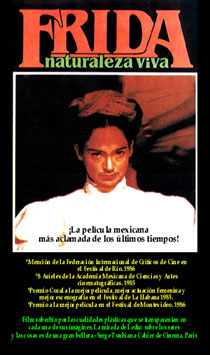 On Wednesday May 16, 2013 at 7:00 p.m. I attended another event in The Revue Cinema’s ‘Creative Women Film Series” which showcases creative and inspirational women. The film selected for this event was Frida Naturaleza Viva (in Spanish with English subtitles, Mexico, 1984), an overview of the life and influences on the art of Frida Kahlo, described in the film’s prologue as the world’s most widely-recognized female Hispanic artist. This is an encore presentation brought back by popular demand, for which I am grateful as I missed the first time. The award-winning production was directed by Paul Leduc and stars Ofelia Medina as Frida. View Trailer.
On Wednesday May 16, 2013 at 7:00 p.m. I attended another event in The Revue Cinema’s ‘Creative Women Film Series” which showcases creative and inspirational women. The film selected for this event was Frida Naturaleza Viva (in Spanish with English subtitles, Mexico, 1984), an overview of the life and influences on the art of Frida Kahlo, described in the film’s prologue as the world’s most widely-recognized female Hispanic artist. This is an encore presentation brought back by popular demand, for which I am grateful as I missed the first time. The award-winning production was directed by Paul Leduc and stars Ofelia Medina as Frida. View Trailer.
Ellen Moorehouse, The Revue’s film series organizer, welcomed Berenice Villagomez, coordinator of University of Toronto’s Latin American Studies program who again introduced this film presented as a pay-what-you-can screening through the generosity of the Consulate General of Mexico in Toronto.
This was not my first introduction to the artist Frida Kahlo. I first heard of her when the 2002 film starring Selma Hayek was being promoted. My first impression from those movie posters came from the artist’s self-portraits, with her heavy eyebrows, exotic floral hair accessories, bright clothing, and pet monkeys amidst lush foliage. I did not see that movie until many years later when the Art Gallery of Ontario presented the Frida and Diego – Passion, Politics, and Painting exhibit and I wanted some more background before attending the exhibit. It was from the 2002 movie that I learned of the basic details of Frida Kahlo’s life including her strong relationship with her father, the tragic bus accident that crippled her and led to miscarriages, her fiery relationship with her philandering husband artist Diego Rivera, her political leanings, and her own passionate encounters with others. While she lay in the hospital her father brought her a painting kit which provided a creative outlet for portraying the joys and sorrows of her life.
Berenice in her introduction to the Frida Naturaleza Viva noted that for those who did not know much about the artist the film might seem hard to follow. I must agree that if I had not seen the 2002 film and attended the AGO exhibit the film might have been somewhat disjointed and confusing, as it has many flashbacks as it moves from the scenes of her apparently idyllic childhood, through the tragedy of the bus accident, her burgeoning artistic career and relationships, the loss of her beloved father, and eventually her own death at 47. This Mexican film portrayal of the artist incorporated a lot more music than the Hollywood version, with the actors portraying Frida and Diego humming and singing to each other throughout the film and portrays many tender moments in her life.
Frida Kahlo is a fascinating subject, and each additional medium that portrays her life and work provides more insights. Some of her art is disturbing and shocking, as were the experiences she had. Her work has been described as “poetry on canvas”, an apt summary. By looking at her art you feel privy to reading her secret diary, with her innermost sentiments laid bare, leaving you bereft, amused, sympathetic, confused, and even horrified. She was a courageous artist whose work posthumously elicits heart-wrenching responses. Her spirit endures through her artistic legacy for all who have the good fortune and empathy to receive them.
Last updated: May 19 2013 G. MacDonald
